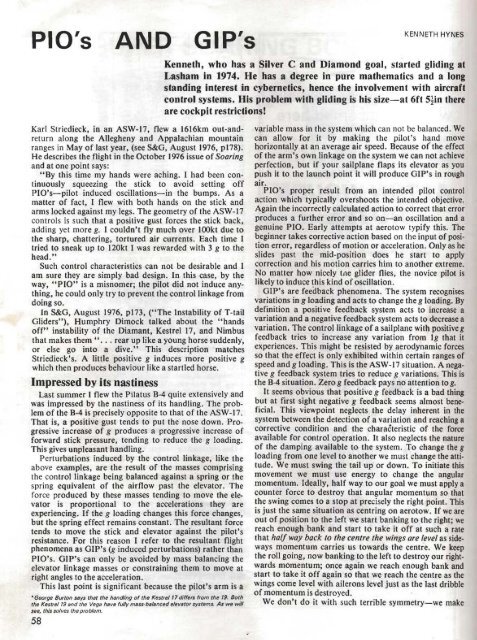Volume 28 No 2 Apr-May 1977.pdf - Lakes Gliding Club
Volume 28 No 2 Apr-May 1977.pdf - Lakes Gliding Club
Volume 28 No 2 Apr-May 1977.pdf - Lakes Gliding Club
- No tags were found...
Create successful ePaper yourself
Turn your PDF publications into a flip-book with our unique Google optimized e-Paper software.
PlO's AND GIP'sKarl Striedieck, in an ASW-I7, flew a 1616km out-andreturnalong the Allegheny and Appalachian mountainranges in <strong>May</strong> of last year, (see S&G, August 1976, pP8).He describes the flight in the October 1976 issue of Soaringand at one point says:"By [his time my hands were aching. I had been continuouslysqueezing the stick to avoid setting offPIO's-pilot induced oscillations-in the bumps. As amatter of fact, I flew with both hands on the stick andarms locked against my legs. The geometry of the ASW-17controls is such that a positive gust forces the stick back,adding yet more g. I couldn't fly much Over IOOkt due tothe sharp, chattering, tortured air currents. Each time Itried to sneak up to 120kt I waS rewarded with 3 g to thehead."Such control character,istics can not be desirable and Iam sure they are simply bad design. In this case, by theway, "PlO" is a misnomer; the pilot did not induce anything,he could only try to prevent the control linkage fromdo,ing so..In S&G, August 1976, 1'173, ("The Instability of T-tailGliders"), Humphry Oimock talked about the "handsoff" instability of the Diamant, Kestrel 17, and Nimbusthat makes them"... rear up like a young horse suddenly;or else go into a dive." This description matchesStriedieck's. A li'ttle positive g induc,es more positive gwhich then produces behaviour like a startled horse.Impressed by its nastinessLast summer I flew the PHatus B-4 quite extensively andwas impressed by the nastiness of its handling. The problemof the 8-4 is precisely opposite to that of the ASW-17.That is, a positive gust tends to put the nose down. Progressiveincrease of g produces a progressive increase offorward stick pressure, tending to reduce the g loading.This gives unpleasant handling.Perturbations induced by the control linkage, like theabove examples, are the result of the masseS comprisingthe control linkage being balanced against a spring or thespring equivalent of the airflow past the elevator. Theforce produced by these masses tending ta move the elevatoris proportional to the accelerations they areexperiencing. If the g loading changes this force changes,but the spring effect remains constant. The resultant forcetends to move the stick and elevator against the pHot'sresistance. For this reason I refer to the resultant flightphenomena as GIP's (g induced perturbations) rather thanPlO's. GIP's, can only be avoided by mass ba'lancing theelevator linkage masses or constraining them to move atright ang es to the acceleration.This last point is significant because the pilot's arm is a• George Qurton says that the handling of the Kestrel 17 differs from the 19. Boththe Kestrel 19 and the Vega have fully mass-balanced elevator' systems. As we willSee. this solves the problem.58KENNETH HYNESKenneth, who has a Silver C and Diamond goal, started gliding atLasham in 1974. He has a degree in pure mathematics and a longsta,nding interest in cybernetics, hence the involvement with aircraftcontrol systems. His problem with gliding is his size-at 6ft 5~in thereare cockpit restrictions!variable mass in the system which can not be balanced. Wecan allow for it by making the pilot's hand movehorizontally at an average air speed. Because or'the effectof the arm's own linkage on the system we can not achieveperfection, but if your sailplane flaps Hs elevator as youpush it to the launch point it will prod\lce GIP's in roughairṖlO's proper result from an intended pilot controlaction which typically overshoots the intended objective.Again the incorrectly calculated action to correct that errorproduces a further error ;md so on-an osciI'lation and agenuine PlO. Early attempts at aerotow typify this. Thebeginner takes corrective action based on the input of positionerror, regardless of motion or acceleration. Only as heslides past the mid-position does he staft to applycorrection and his motion carries him to another extreme.<strong>No</strong> matter how nicely tile glider tlies, the novice pilot islikely to induce this kind of oscillation.GIP's are feedback phenomena. The system recognisesvariations in g loading and acts to change the g loading. Bydefinition a positive feedback system acts to increase avariation and a negative feedback system acts to decrease avariation. The control linkage of a sailplane with positive gfeedback tries to increase any variation from 19 that itexperiences. This might be resisted by aerodynamic forcesso that the effect is only exhibited within certain ranges ofspeed and g loading. This is the ASW-17 situation. A negativeg feedback system tries to reduce g variations. This ,isthe B-4 situation. Zero g feedback pays no attention to g.It seems obvious tJhat positive g feedback is a bad thingbut at first sight negative g feedback seems almost beneficiaLThis viewpoint neglects the delay inherent in thesystem between the detection of a variation and reaching acorrective condition and the characteristic of the forceavailable for control operation. It also neglects the natureof the damping available to ,the system. To change the gloading from one levet to another we must chan,ge ,the attitude.We must swing the tail up' or down. To initiate thismovement we must use energy to change the angularmomentum. Ideally,. half way to our goal we must apply acounter force to destroy that angular momentum so thatthe swing comes to a stop at precisely Ithe right point. Thisis just the same situation as centring on aerotow. If we areout of position to the left we start banking to the right; wereach enough bank and start to take it off at such a rate,that half way back to the centre the wings are level as sidewaysmo~entum carries us towards the centre. We keepthe roll gomg, now banking to the left to destroy our rightwardsmomentum; once 'again we reach enough bank andstart to take it off again so that we reach the centre as thewings come level with ailerons level just as the last dribbleof momentum is destroyed.We don't do it with such terrible symmetry-we make
















